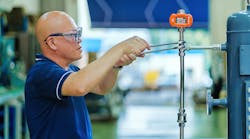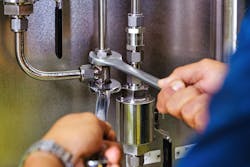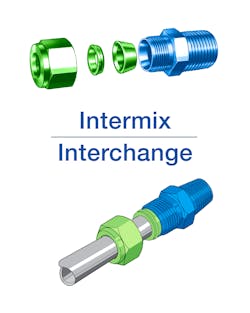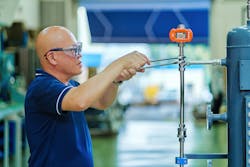Why You Shouldn’t Use Tube Fittings from Different Manufacturers in the Same System
Using consistent tube fittings can mean the difference between well-functioning fluid systems and ones that are often down for repairs. While some suppliers may tell you that intermixing and interchanging the tube fitting components used in your systems is fine, those claims should be met with skepticism. That’s because the component manufacturing tolerances may not match precisely.
In addition, the material composition of the components may differ. In either case, leaks may occur, leading to unforeseen downtime, unnecessary repair costs and possible safety risks for your employees (Fig. 1). To prevent these issues proactively, you should never intermix or interchange tube fittings from different suppliers.
The Difference Between Intermix and Interchange
While subtle, the difference between intermixed and interchanged components is essential to understanding why either practice should be avoided.
- Intermix occurs when tube fitting components, including the nuts, ferrules and bodies from two or more manufacturers, are mixed together and then assembled to make a completed fitting.
- Interchange occurs when a tube fitting from one manufacturer that has been installed on a piece of tubing is then disassembled, and the tubing, nut and ferrules are then reassembled into a tube fitting body from another manufacturer.
The Problems with Intermixing and Interchanging
The biggest challenge facing engineers who are considering intermixing and interchanging fluid system components is that no industry-wide standard exists for tube fittings. What that means practically is that each manufacturer sets its own design standards and processes. While sometimes those differences are small, they are often significant and can cause problems to fluid system operations.
It is nearly impossible for manufacturers to copy designs from different manufacturers with any reliability or uniformity. Though the practice of intermixing and interchanging may save costs in the short term, the potential costs associated with system failures far outweigh the savings achieved through the practice.
To be clear: Unless tube fitting components are specifically designed to work together—and with products from competitors—they create new, unvalidated designs that were not intended by the original design engineer (Fig. 2). Some of the potential problems caused by intermixed and interchanged components include:
- Inconsistent sealing surfaces due to design, construction and torque value differences
- Sealing surface incompatibilities due to geometry, tolerances and metallurgic properties
- Compromised function and leaks caused by overtightening the nut
- Fatigue failure as a result of cyclic loading that permanently deforms the fitting components
- Ineffective sealing surfaces resulting from different swaging mechanisms, material hardness and tolerance variations
Not only could using components from different manufacturers in the same tube fitting cause unpredictable performance, increased costs and potential safety hazards, but doing so may also render warranties null and void. Should the intermixed or interchanged components fail, having no warranty could increase repair and replacement costs over the life of the system (Fig. 3).
Intermixing and Interchanging are Bad Engineering Practices
For most fluid system standards agencies, the practice of intermixing or interchanging components from different suppliers is strongly discouraged. The way to avoid intermixing and interchange is to source all your facility’s tube fittings from a single reliable supplier. When there is only one manufacturer specified, it cuts down on the chances that technicians will make the mistake of using noncompatible components from two different manufacturers.
Reputable suppliers should be able to advise you on best practices for fluid system design and construction, and should offer in-depth training to make sure your team understands the dangers of intermixing and interchanging components. In the end, investing time and effort up front will help you avoid fluid system problems down the road.
Jon Kestner is senior product line manager for Swagelok Company. A version of this article appeared on the Swagelok Reference Point blog.



